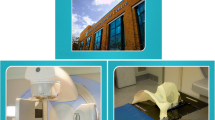Abstract
Patients treated for lung cancer are often elderly presenting a unique challenge for developing patient education materials. This study developed and evaluated a patient education pamphlet on lung stereotactic body radiotherapy (SBRT) designed specifically for an elderly population. The SBRT pamphlet was developed using a participatory design involving a convenience sample of patients. This prospective study assessed patient’s opinions of pamphlet effectiveness through self-report questionnaires. The pamphlet was deemed “effective” if patients rated 16/18 evaluation statements as “strongly agree” or “agree.” Demographic data and health literacy (Rapid Estimate of Adult Literacy in Medicine short-form (REALM-SF)) were also assessed. Patient opinion of pamphlet “effectiveness” was compared between patients with REALM-SF scores of 7 versus <7 using Fisher’s exact test. The overall EQ-5D-5L score was compared for patients who did and did not find the pamphlet effective using the Wilcoxon-Mann-Whitney test. Thirty-seven patients participated. The median age was 76 years (range 56–93) and 22 patients (59 %) had ≤high school education. Most patients preferred to have verbal (65 %) or written (78 %) educational materials as opposed to online information or educational classes. Thirty-two patients (86 %) rated the pamphlet as effective. The proportion of patients who found the pamphlet effective was 85.7 versus 86.7 % (p = 1.00) in those with REALM 7 versus <7. The mean EQ-5D score was 67.5 (SD 19.1) versus 71.8 (SD 8.7) (p = 0.84) in those who found the pamphlet effective versus not. Participatory design is an effective method for developing education materials for challenging patient groups such as elderly patients. Despite advanced age and comorbidity, this patient group had adequate health literacy.
Similar content being viewed by others
References
Dahele M, Pearson S, Purdie T, Bissonnette JP, Franks K, Brade A, Cho J, Sun A, Hope A, Marshall A, Higgins J, Bezjak A (2008) Practical considerations arising from the implementation of lung stereotactic body radiation therapy (SBRT) at a comprehensive cancer center. J thorac oncol: off pub Int Assoc Study Lung Cancer 3:1332–1341
Halkett GK, Arbon P, Scutter SD, Borg M (2007) The phenomenon of making decisions during the experience of early breast cancer. Eur J Cancer Care 16:322–330
Halkett GK, Kristjanson LJ, Lobb E, Little J, Shaw T, Taylor M, Spry N (2012) Information needs and preferences of women as they proceed through radiotherapy for breast cancer. Patient Educ Couns 86:396–404
Halkett GK, Kristjanson LJ (2007) Patient’s perspectives on the role of radiation therapists. Patient Educ Couns 69:76–83
Guleser GN, Tasci S, Kaplan B (2012) The experience of symptoms and information needs of cancer patients undergoing radiotherapy. J Cancer Educ 27:46–53
Rozmovits L, Ziebland S (2004) What do patients with prostate or breast cancer want from an internet site? A qualitative study of information needs. Patient Educ Couns 53:57–64
Eysenbach G, Kohler C (2002) How do consumers search for and appraise health information on the World Wide Web? Qualitative study using focus groups, usability tests, and in-depth interviews. BMJ 324:573–577
Zarcadoolas C, Pleasant A, Greer DS (2003) Elaborating a definition of health literacy: a commentary. J Health Commun 8(Suppl 1):119–120
Wolf MS, Gazmararian JA, Baker DW (2005) Health literacy and functional health status among older adults. Arch Intern Med 165:1946–1952
Dewalt DA, Berkman ND, Sheridan S, Lohr KN, Pignone MP (2004) Literacy and health outcomes: a systematic review of the literature. J Gen Intern Med 19:1228–1239
Sudore RL, Yaffe K, Satterfield S, Harris TB, Mehta KM, Simonsick EM, Newman AB, Rosano C, Rooks R, Rubin SM, Ayonayon HN, Schillinger D (2006) Limited literacy and mortality in the elderly: the health, aging, and body composition study. J Gen Intern Med 21:806–812
Canadian Public Health Association. A vision for a health literate Canada: report of the expert panel on health literacy. 2008
Timmerman RD (2010) Surgery versus stereotactic body radiation therapy for early-stage lung cancer: who’s down for the count? J clin oncol: off j Am Soc Clin Oncol 28:907–909
Wilson FL, Mood D, Nordstrom CK (2010) The influence of easy-to-read pamphlets about self-care management of radiation side effects on patient’s knowledge. Oncol Nurs Forum 37:774–781
Lillie SE, Brewer NT, O’Neill SC, Morrill EF, Dees EC, Carey LA, Rimer BK (2007) Retention and use of breast cancer recurrence risk information from genomic tests: the role of health literacy. Cancer Epidemiol Biomark Prev 16:249–255
Berkman ND, Sheridan SL, Donahue KE, Halpern DJ, Viera A, Crotty K, Holland A, Brasure M, Lohr KN, Harden E, Tant E, Wallace I, Viswanathan M (2011) Health literacy interventions and outcomes: an updated systematic review. Evid rep/technol assess 1–941
Shuler D, Namioka A. Participatory design: principles and practices.Mahwah: Lawrence Erlbaum Associates Inc.; 1993.
Adirim T, Chafranskaia A, Nyhof-Young J (2010) Investigating the impact of socioeconomic status on the effectiveness of a pamphlet on achieving and maintaining bone health in breast cancer survivors: a patient education resource development primer. J Cancer Educ 27:54–58
Arozullah AM, Yarnold PR, Bennett CL, Soltysik RC, Wolf MS, Ferreira RM, Lee SY, Costello S, Shakir A, Denwood C, Bryant FB, Davis T (2007) Development and validation of a short-form, rapid estimate of adult literacy in medicine. Med Care 45:1026–1033
Herdman M, Gudex C, Lloyd A, Janssen M, Kind P, Parkin D, Bonsel G, Badia X (2011) Development and preliminary testing of the new five-level version of eq-5d (eq-5d-5l). Qual Life Res 20:1727–1736
Pickard AS, De Leon MC, Kohlmann T, Cella D, Rosenbloom S (2007) Psychometric comparison of the standard eq-5d to a 5 level version in cancer patients. Med Care 45:259–263
Paasche-Orlow MK, Parker RM, Gazmararian JA, Nielsen-Bohlman LT, Rudd RR (2005) The prevalence of limited health literacy. J Gen Intern Med 20:175–184
Author information
Authors and Affiliations
Corresponding author
Rights and permissions
About this article
Cite this article
Jewitt, N., Hope, A.J., Milne, R. et al. Development and Evaluation of Patient Education Materials for Elderly Lung Cancer Patients. J Canc Educ 31, 70–74 (2016). https://doi.org/10.1007/s13187-014-0780-1
Published:
Issue Date:
DOI: https://doi.org/10.1007/s13187-014-0780-1




